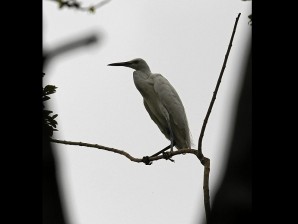In Tacurong, bird haven faces threat

BIRDS take flight (top right) around a sanctuary in Tacurong City in this photo taken on Aug. 4. A lone migratory bird (left) takes a rest in the sanctuary, which offers haven to at least 20,000 birds of different types that hunt for food, particularly fish, in the area. JEOFFREY MAITEM
First of a series)
TACURONG CITY, Sultan Kudarat—It began at daybreak in February 1996. Rey Oliver Malana roused to songbirds chirping and looked up to see four black and white herons perched on a branch of a rambutan tree in the family-owned, 15,000-square meter black peppercorn farm.
From afar, Malana watched the birds stay and fly away till sundown. As darkness crept, he killed time to await their return, but they never did.
Until the next morning, he would hear the same throaty “qouk” of the four short and stocky birds with streaks of white, black and gray wing patch.
Those were birds, after all, and Malana thought, are they going to stay? Sure enough, they did as he studied the patterns of the birds.
Article continues after this advertisement“The birds leave late afternoon, at 5:30, and fly back around 6 in the morning,” he says.
Article continues after this advertisementEach time they come back, the birds bring company until their number grew to a few hundred by yearend, hanging about the kakawate and rambutan trees by the farm.
Escape from winter
They started coming at the compelling might of approaching winter across Europe and Asia, and they came in dramatic flocks.
Malana’s brood welcomed the sight of birds flying, mostly belonging to the families of egrets and herons, roosting on the tree branches.
“Their population has gone extraordinarily big and diverse,” Malana says. As the months progressed, the birds have rapidly multiplied, built their nests and hatched.
Fast forward today. Malana’s marshy farm by the ridges of the Banga River in the sparsely populated Barangay Baras in Tacurong City, is an improbable haven of migratory birds and natural place to linger for hours at sunbreak and just before it sets.
Nonstop bird music
“We have learned to enjoy their presence, even at the beginning when they were a few. The air we breathe is full of them, their sing-song chirrup is music to us nonstop. They’re family to us now,” Malana says.
In a bumpy road amid the oil palm plantation, 7 kilometers off the city, the Baras Bird Sanctuary boasts of egrets and herons of diverse breeds. Malana puts their number at 20,000.
Now considered a bird sanctuary, Malana’s glorious days of harvest in the pepper farm, which made profits for the family yielding at least 4 tons a year, are gone.
“I gave it up,” he says, “it’s impossible for the peppers to survive the number of birds homing in the farm.” Luckily, other portions of the family-owned 5-hectare land are planted with rice that supports his family.
Malana’s wife, Marie Ann, and four children have come to love the birds. “To people who have come to know this place, this place is for you,” says the former seaman who has circled the globe and joined safaris overseas.
A bird lover since childhood, Malana once cared for pigeons, Brahmini eagle and more. He sighs with disbelief at his current flock. “I have never thought that I will have this massive shelter for birds. I just can’t believe this.”
Herons and egrets
Two bird species—egrets (with orange breast and black crown and back) and herons (plumage of black, gray and white with two plumes on the nape)—have considered Malana’s farm home for 15 years now.
There are great egrets, intermediate egrets, little egrets and cattle egrets. The herons include the black-crowned night heron, rufous heron and Javan pond heron.
Malana claimed to have seen the endangered Chinese egret, but he has lost monitoring its movement due to the massive number of birds.
The population is abundantly distributed to the nocturnal black-crowned night heron, believed to have flown from Korea and Japan (Nycticorax) and the endemic cattle egret (tulabong), that is commonly seen in rice paddies hunting for food.
Breeding peaks in February and March, but the birds lay eggs, a little larger than a ping-pong ball, year round.
Swampland
Egrets and herons prefer to stay in Tacurong as swamps straddle the entire Sultan Kudarat province, according to Malana. “The sources abound,” he says.
Lake Sebu in the south, Lake Buluan in the east, the Ligawasan Marsh in the north, and the shores of Lebak in the west are rich sources of food for the feathered creatures.
Why the birds return and keep growing could be traced to the efforts of Malana’s family. Malana had set aside over 1 hectare of land as bird habitat.
